The iPhone 5 Performance Preview
by Anand Lal Shimpi on September 21, 2012 11:31 PM EST- Posted in
- Smartphones
- Apple
- Mobile
- SoCs
- iPhone 5
This morning we finally got our hands on Apple's iPhone 5. While we are eager to get started on battery life testing, that'll happen late tonight after a full day's worth of use and a recharge cycle. Meanwhile, we went straight to work on performance testing. As we've mentioned before, the A6 SoC makes use of a pair of Apple's own CPU cores that implement the ARMv7 ISA. These aren't vanilla Cortex A9s or Cortex A15s, but rather something of Apple's own design. For its GPU Apple integrated a PowerVR SGX543MP3 GPU running at higher clocks than the dual-core 543MP2 in the A5. The result is compute performance that's similar to the A5X in Apple's 3rd generation iPad, but with a smaller overall die area. The A6 has a narrower memory interface compared to the A5x (64-bits vs. 128-bits), but that makes sense given the much lower display resolution (0.7MP vs. 3.1MP).
As always, our performance analysis starts out on the CPU. Although we originally thought the A6 ran its two CPU cores at 1GHz, it looks like max clocks range between 800MHz and 1.2GHz depending on load. Geekbench reports clock speed at launch, which varied depending on CPU load. With an app download process in the background I got Geekbench to report a 1.2GHz clock speed, and with everything quiet in the background the A6 reported 800MHz after being queried. This isn't anything new as dynamic voltage/frequency adjustment is in all smartphones, but we do now have a better idea of the range.
The other thing I noticed is that without a network active I'm able to get another ~10% performance boost over the standard results while on a network. Take the BrowserMark results below for example, the first two runs are without the iPhone 5 being active on AT&T's network while the latter two are after I'd migrated my account over. The same was true for SunSpider performance, I saw numbers in the low 810ms range before I registered the device with AT&T.
Overall, the performance of the A6 CPU cores seems to be very good. The iPhone 4S numbers below are updated to iOS 6.0 so you can get an idea of performance improvement.
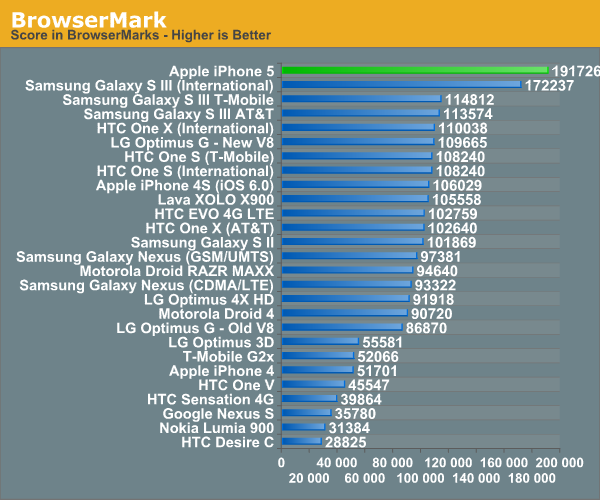
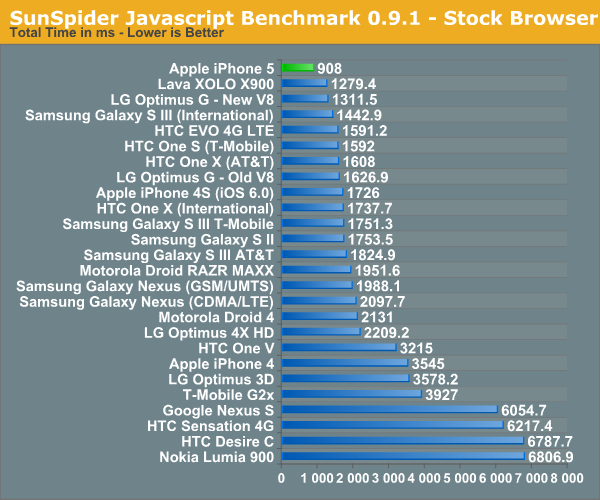
As we mentioned in our earlier post, SunSpider is a small enough benchmark that it really acts as a cache test. The memory interface on the A6 seems tangibly better than any previous ARM based design, and the advantage here even outpaces Intel's own Medfield SoC.
I also ran some data using Google's V8 and Octane benchmarks, both bigger JavaScript tests than SunSpider. I had an AT&T HTC One X with me while in New York today (up here for meetings this week) and included its results in the charts below. Note that the default HTC web browser won't run the full Octane suite so I used Chrome there. I didn't use Chrome for the V8 test because it produced lower numbers than the stock browser for some reason.
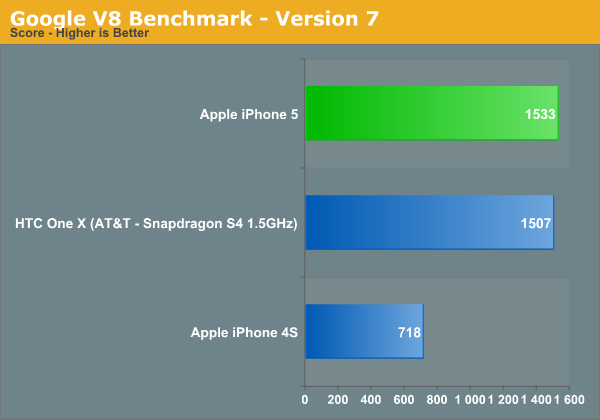
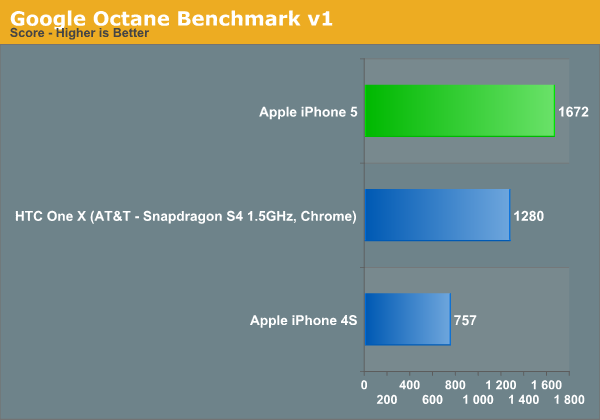
Here we see huge gains over the iPhone 4S, but much closer performance to the One X. In the case of Google's V8 benchmark the two phones are effectively identical, although Octane gives the iPhone 5 a 30% lead once more.
These are still narrowly focused tests, we'll be doing some more holisitic browser tests over the coming days. Finally we have Geekbench 2, comparing the iPhone 5 and 4S:
| Geekbench 2 Performance | ||||
| Geekbench 2 Overall Scores | Apple iPhone 4S | Apple iPhone 5 | ||
| Geekbench Score | 628 | 1640 | ||
| Integer | 545 | 1252 | ||
| Floating Point | 737 | 2101 | ||
| Memory | 747 | 1862 | ||
| Stream | 299 | 946 | ||
Apple claimed a 2x CPU performance advantage compared to the iPhone 4S during the launch event for the 5. How does that claim match up with our numbers? Pretty good actually:
This is hardly the most comprehensive list of CPU benchmarks, but on average we're seeing the iPhone 5 deliver 2.13x the scores of the iPhone 4S. We'll be running more application level tests over the coming days so stay tuned for those.
A6 GPU Performance: Nearly Identical to the iPad 3
Before we got a die shot of Apple's A6 we had good information pointing to a three core PowerVR SGX 543MP3 in the new design. As a recap, Imagination Technologies' PowerVR SGX543 GPU core features four USSE2 pipes. Each pipe has a 4-way vector ALU that can crank out 4 multiply-adds per clock, which works out to be 16 MADs per clock or 32 FLOPS. Imagination lets the customer stick multiple 543 cores together, which scales compute performance linearly. The A5 featured a two core design, running at approximately 200MHz based on our latest news. The A5X in the 3rd generation iPad featured a four core design, running at the same 200MHz clock speed.
The A6 on the other hand features a three core PowerVR SGX 543MP3, running at higher clock speeds to deliver a good balance of die size while still delivering on Apple's 2x GPU performance claim. The raw specs are below:
| Mobile SoC GPU Comparison | |||||||||||
| Adreno 225 | PowerVR SGX 540 | PowerVR SGX 543MP2 | PowerVR SGX 543MP3 | PowerVR SGX 543MP4 | Mali-400 MP4 | Tegra 3 | |||||
| SIMD Name | - | USSE | USSE2 | USSE2 | USSE2 | Core | Core | ||||
| # of SIMDs | 8 | 4 | 8 | 12 | 16 | 4 + 1 | 12 | ||||
| MADs per SIMD | 4 | 2 | 4 | 4 | 4 | 4 / 2 | 1 | ||||
| Total MADs | 32 | 8 | 32 | 48 | 64 | 18 | 12 | ||||
| GFLOPS @ 200MHz | 12.8 GFLOPS | 3.2 GFLOPS | 12.8 GFLOPS | 19.2 GFLOPS | 25.6 GFLOPS | 7.2 GFLOPS | 4.8 GFLOPS | ||||
| GFLOPS As Shipped by Apple/ASUS | - | - | 12.8 GFLOPS | 25.5 GFLOPS | 25.6 GFLOPS | - |
12 GFLOPS |
||||
The result is peak theoretical GPU performance that's near identical to the A5X in the 3rd generation iPad. The main difference is memory bandwidth. The A5X features a 128-bit wide memory interface while the A6 retains the same 64-bit wide interface as the standard A5. In memory bandwidth limited situations, the A5X will still be quicker but it's quite likely that at the iPhone 5's native resolution we won't see that happen.
We ran through the full GLBenchmark 2.5 suite to get a good idea of GPU performance. Note that the 3rd gen iPad results are still on iOS 5.1 so there's a chance you'll see some numbers change as we move to iOS 6.
We'll start out with the raw theoretical numbers beginning with fill rate:
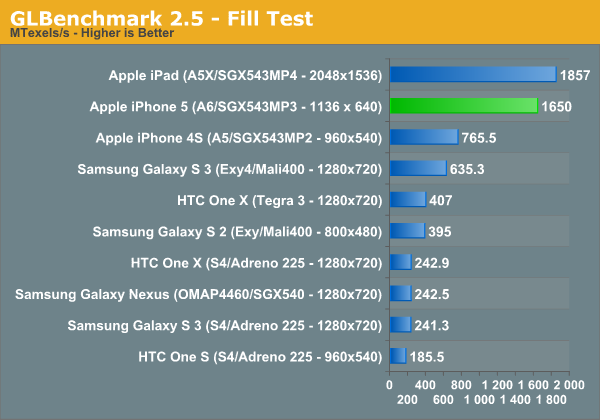
The iPhone 5 nips at the heels of the 3rd generation iPad here, at 1.65GTexels/s. The performance advantage over the iPhone 4S is more than double, and even the Galaxy S 3 can't come close.
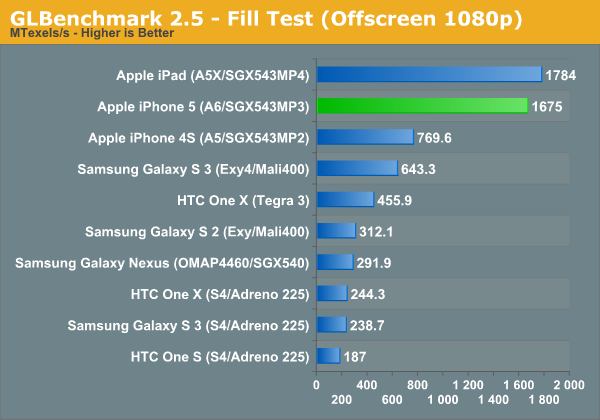
Triangle throughput is similarly strong:
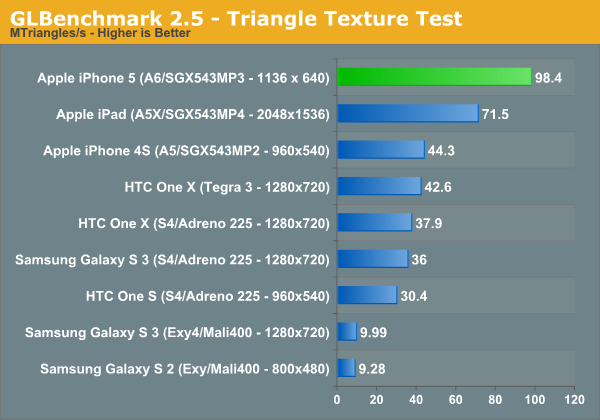
Take resolution into account and the iPhone 5 is actually faster than the new iPad, but normalize for resolution using GLBenchmark's offscreen mode and the A5X and A6 look identical:
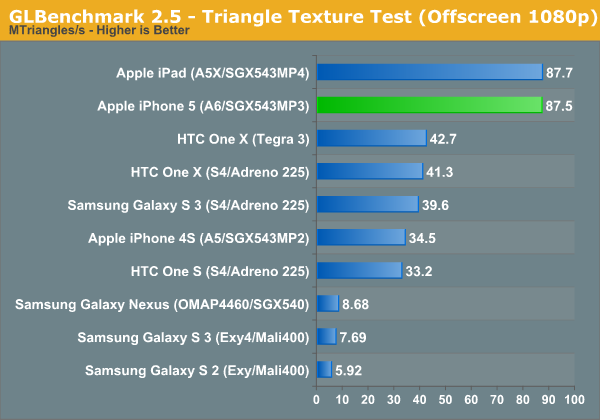
The fragment lit texture test does very well on the iPhone 5, once again when you take into account the much lower resolution of the 5's display performance is significantly better than on the iPad:
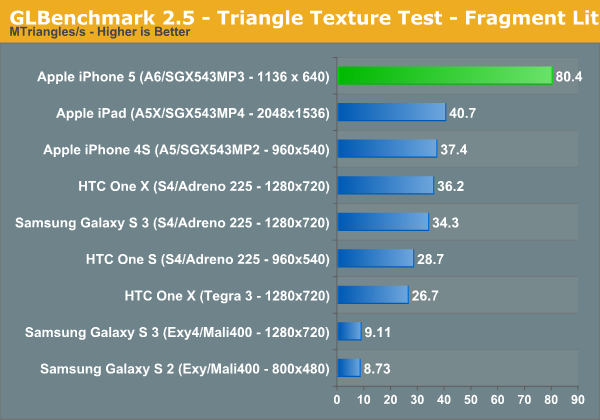
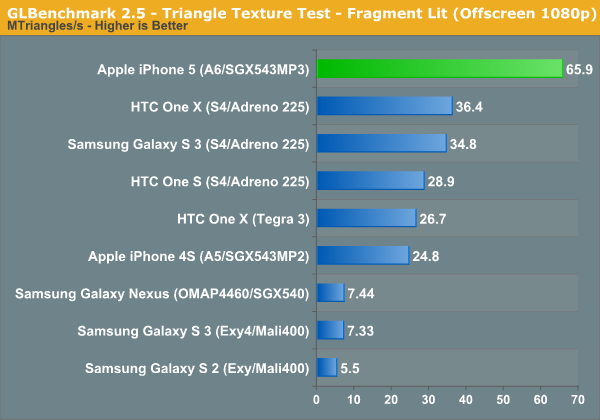
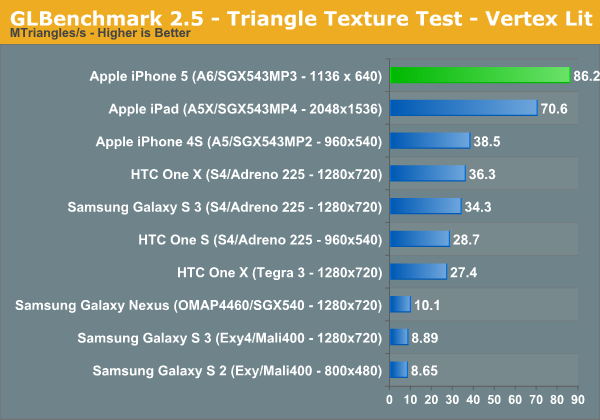
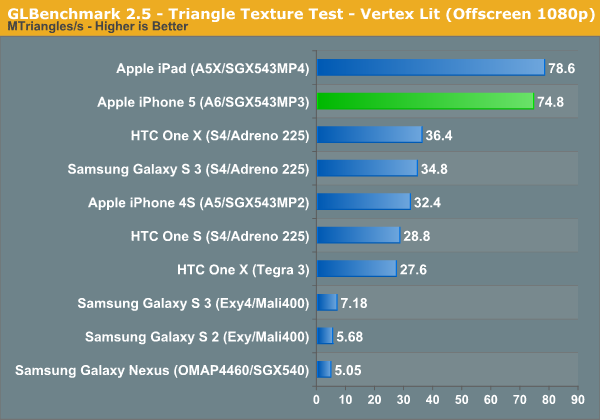
The next set of results are the gameplay simulation tests, which attempt to give you an idea of what game performance based on Kishonti's engine would look like. These tests tend to be compute monsters, so they'll make a great stress test for the iPhone 5's new GPU:
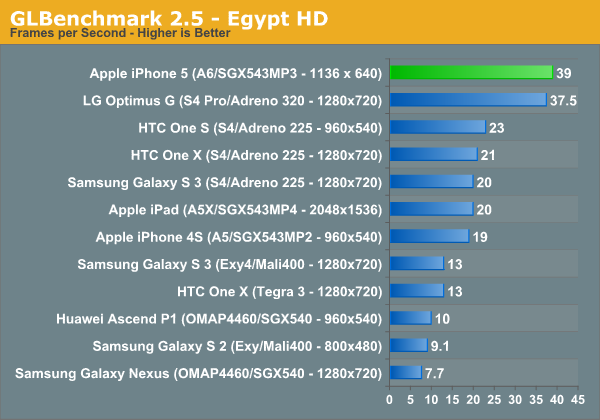
Egypt HD was the great equalizer when we first met it, but the iPhone 5 does very well here. The biggest surprise however is just how well the Qualcomm Snapdragon S4 Pro with Adreno 320 GPU does by comparison. LG's Optimus G, a device Brian flew to Seoul, South Korea to benchmark, is hot on the heels of the new iPhone.
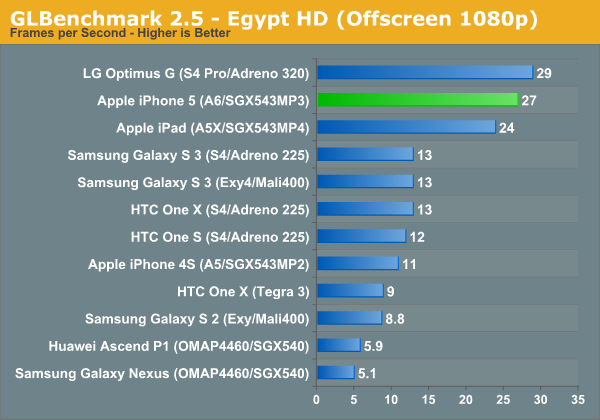
When we run everything at 1080p the iPhone 5 looks a lot like the new iPad, and is about 2x the performance of the Galaxy S 3. Here, LG's Optimus G actually outperforms the iPhone 5! It looks like Qualcomm's Adreno 320 is quite competant in a phone.
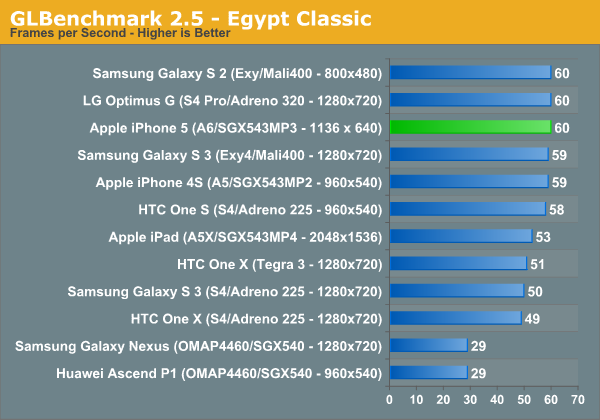
The Egypt classic tests are much lighter workloads and are likely a good indication of the type of performance you can expect from many games today available on the app store. At its native resolution, the iPhone 5 has no problems hitting the 60 fps vsync limit.

Remove vsync, render at 1080p and you see what the GPUs can really do. Here the iPhone 5 pulls ahead of the Adreno 320 based LG Optimus G and even slightly ahead of the new iPad.
Once again, looking at GLBenchmark's on-screen and offscreen Egypt tests we can get a good idea of how the iPhone 5 measures up to Apple's claims of 2x the GPU performance of the iPhone 4S:
Removing the clearly vsync limited result from the on-screen Egypt Classic test, the iPhone 5 performs about 2.26x the speed of the 4S. If we include that result in the average you're still looking at a 1.95x average. As we've seen in the past, these gains don't typically translate into dramatically higher frame rates in games, but games with better visual quality instead.
Final Words
We still have a lot of work ahead of us, including evaluating the power profile of the new A6 SoC. Stay tuned for more data in our full review of the iPhone 5.


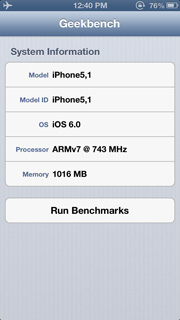

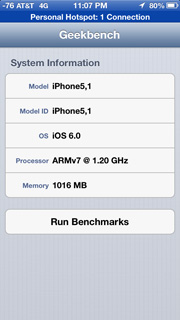
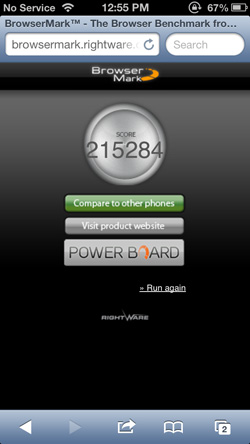
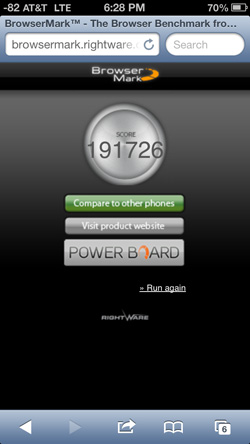










237 Comments
View All Comments
techconc - Friday, September 28, 2012 - link
Same here. I've had nothing but very positive experience with Apple's maps so far. While I don't doubt some issues exist in some places, I'm quite certain that it's nowhere near as bad as what's being reported by the tech press.tnicks - Saturday, September 22, 2012 - link
Show us one example where maps actually screwed up for you that wasn't posted on the net. I agree some of the stuff posted the last few days is laughable, but I've yet to find something not working in my area and I would imagine that holds true for at least 90% of us. It's ridiculous to call it unforgivable, give me a break.There are millions of iphone users that couldn't give two shits about apple vs everyone else. People buy them simply because they are the standard every other manufacturer tries to imitate. They work extremely well minus a few overblown issues that are bound to crop up in any product given so much scrutiny.
L-Set - Saturday, September 22, 2012 - link
Do you live in the US tnicks? Because if you live outside of the states and don't live in a major city then yes, it is pretty poor from all of the reports I've had (from friends, not just random net users). The town where I live in the UK, the population is around 100,000 people, and it's just a giant green patch on maps. I'm not an iphone user, but this is my friend showing me on his updated 4S at work on Friday, it's a bit of a joke. The 5 is clearly a very good phone (benchmarks alone show what a good job Apple have done with the A6), but this had been a PR disaster.And like you said, there are millions of iphone users. Release a new bit of software that doesn't fully work as people intended and of course it's going to blow up!
kyuu - Sunday, September 23, 2012 - link
"People buy them simply because they are the standard every other manufacturer tries to imitate."No, they buy them because they simply aren't paying attention and/or are locked into the Apple ecosystem. Apple's competitors have long since passed them up in terms of both OS and hardware design.
robinthakur - Monday, September 24, 2012 - link
Keep telling yourself that! I had an S3 back in June and sold it after a month and went back to Apple, because I found life is still much worse on the Android side, apart from the OS customisability aspect and widgets, despite how much things have improved since my last Android phone. Those last two aspects are not as important if a competing phone does everything you want without customisation though.-There is no iTunes equivalent, you have to drag and drop everything, which is simply not practical for most people with complex playlists. You might think that you won't mis iTunes, but IME, there is nothing which does so much an offers the 'one-stop' convenience.
-Simple stuff like music playback is mind bogglingly complex to use when the phone is locked becasue you can't put a music playback control on the lock screen using the stock rom. A lot of the software both on the S3 and the supporting software like Kies feels under developed and unreliable.
-Tthe Apps available remain a poor shadow of the Apple ecosystem. Even the apps which do exist on both platforms are usually feature incomplete on Android. The only apps which are leagues better are the Google ones, which I miss slightly.
-The hardware and design of the iPhones blows away anything Samsung or anybody else for that matter have come up with to date. It is refined and feels like quality, not the cheap, thin plastic of the Galaxy, which is supposed to be a flagship device. The screen, whilst bigger on the G3 has a cold tint to the colours on the display and it not retina quality (it looks fuzzy round the sides of text)
-If you want to talk about lock in, there are features on the Galaxy 3 which will only work with other people who own the Galaxy 3 like the photoshare thing, which is hardly useful, and a great deal of what Samsung added to Android like 'S Assist' and 'Smart-stay' just don't work very well.
I'm a power user and know exactly what i'm buying and the reasons for this. Stop patronising people who have weighed up all the pros and cons of a device's hardware and software integration, plus their own needs and opted for a choice other than yours. I would happily buy whatever device I find to be the best, the cost is only one consideration, and for now that device is the iPhone 5.
amdwilliam1985 - Tuesday, September 25, 2012 - link
lol, you listed iTunes as a positive point?NO ONE I come across in real life defends that POS, not even the most die hard Apple lovers. Apparently, my magical experience did not match up to yours, every time I sync with my old iPhone, something goes wrong, in one of the worst case scenario, my prayer didn't go right with Lord Steve J, and all my photos were gone!!!
It's got to be the worst piece of shit in the history of all garbage software. I ran iTunes in windows 7 and 10.7 OSX before.
Biggest reason why I'm left iPhone.
Someone also mentioned iOS being smooth, sigh... my MOTO Razor flip phone was smoother than any iPhone. But that didn't make my stick to it, I wonder why?
moogleii - Monday, September 24, 2012 - link
Sure, software if you're willing to buy every year, since it seems most androids get left out in the cold when it comes to OS upgrades. And if you're ok with a few glaring bugs. My friend's Android often won't show the full keypad after she locks it, which means she can't unlock the phone without rebooting. Not saying Apple software is bug free, but that's pretty a fundamental bug.Hardware design, how? NFC? That's currently a gimmick/non-standard. I have never seen anyone use their android for that; heck, people barely ever use the wireless feature on their CCs. More RAM? Well the tests historically have shown that hasn't seemed to matter, I suspect partly because Android needs the Dalvik virtual machine to be running full time.
Yes, vastly superior indeed.
jameskatt - Saturday, September 22, 2012 - link
There is more to a smartphone than a map app.There are many map apps for the iPhone.
The built in one is guaranteed to get better with time particularly with the help of third parties who specialize in maps.
Maps works well for me. Routes and locations are fine.
The iPhone 5 is a whole lot of FUN!
kmmatney - Saturday, September 22, 2012 - link
I've had some major screw ups with Google maps over the last few years. I think a lot of this is overblown. You can also download other map apps, such as MapQuest, which gives you turn by turn navigation.addicted44 - Saturday, September 22, 2012 - link
I do believe Apple's data is a little behind Google's but that will get resolved in a matter of months. I don't think it is even close to a major issue at this point. Might be a little worse initially when it starts selling in more countries since I assume international data will be weaker.That being said, it is based on OpenStreetMaps with an open data set anyone can contribute to, and a bunch of companies are supporting it over the proprietary Google maps data. I wouldnt be surprised at all to see it far exceed Google Maps's data set within this calendar year itself, especially after Apple starts adding to it based on the data they get from iPhone users.
Personally, i haven't had any issues at all. Initially I was annoyed by having to download a new app for transit directions, but after a couple of days I love it, because the app gives me advisories and offline maps, which the older Maps could t do. And the usage of vector base maps, as opposed to bitmaps has made the map browsing experience much better.